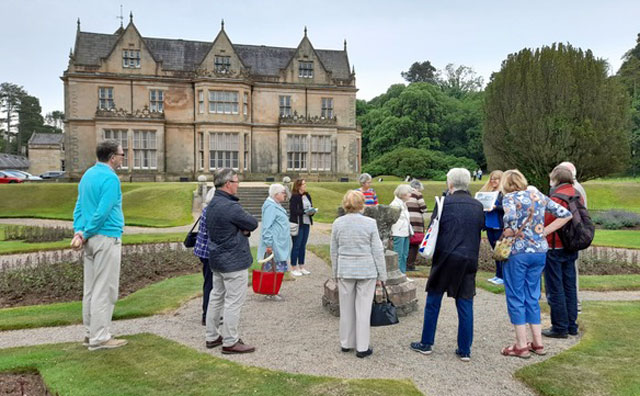As covid regulations relax Bangor Historical Society has resumed its activities by beginning a series of outdoor visits for members. The first one was held on the 1st of July 2021 when members assembled outside the North Down Museum. Leanne Briggs from the Museum then took us round the exterior of Bangor Castle and in the words of the chairman Ian Wilson “shared her encyclopedic knowledge” with us.

We began at the “bridge” and looked at the area below where deliveries were made and the cold stores and museum stores are now situated. Once this was the working end of the house and the servants entered here. then we walked towards the main door where Leanne pointed out the date 1852 and the initials REW above the door. Robert Edward Ward had built Bangor Castle as a family home to replace the earlier one which dated from the late eighteenth century. It cost £9,000.
Close by on the wall is a blue plaque in memory of his grandson Barry Bingham. He was awarded a VC for his role in the Battle of Jutland in which the Royal Navy fought the German fleet in 1916. He later became a prisoner of war. When he returned to Bangor he hoped for a quiet arrival at Bangor Station, but instead he was given a great reception by the local citizens. The town was also granted a German gun which still stands in Ward Park. Barry Bingham was one of 10 children of Maude Ward the only child of R.E.Ward. She had married Lord Clanmorris of the Bingham family.
The castle had 35 bedrooms altogether. The entertaining rooms were on the ground floor while the top of the house was reserved for the children. The servants were housed in the basement. We were shown a grill in the ground close to the front door where it was possible to peer down into the corridor used by the servants. The ghost of Maude, Lady Clanmorris is supposed to haunt the basement in order to listen to servants’ gossip. Several people claim to have heard children’s voices etc there. In 1941 after the death of Lady Clanmorris the castle was purchased by Bangor Borough Council for £35,000. The Second World War meant refurbishment was delayed and it was several years later that the council staff were able to move in.

then we moved to the flower bed close to the entrance where a pillar stands that is often overlooked. It is in fact a sundial from the ancient Bangor Abbey and dates to the eighth or nineth century. Unfortunately, the gnomon or pointer is missing.
then we moved to the front of the house which has a distant view of Belfast Lough. A bench stands close to the wall of the house. It commemorates the writer C.S.Lewis who regularly returned to the area and stayed in Crawfordsburn. His visits were recorded in the County Down Spectator.
Leanne then explained that this castle was the third building in the area. The first house, belonging to Sir James Hamilton, was shown on the Raven Maps of 1625 and stood some distance from the present one. The second house was built in the late eighteenth century and stood near the site of the flagpole. It was constructed by a member of the Ward family, descendants and heirs of one of Sir James’ brothers. Only a few stones and a tunnel survive from it. The latter was a drain and goes under the road to the car park. Animal bones and oyster shells were found in it. It is now blocked off.
We then walked down the steps to view a badly degraded stone which was brought from Tunisia by a member of the Ward family. It was a capital from a building dating to about 300BC. We looked down towards the railway station and Leanne pointed out that there was once a demesne wall which divided the estate from Abbey Street. The local council wanted to take it down in order to widen Abbey Street. Some members of the family opposed this, but Lady Clanmorris agreed. From this point we could see that some of the chimneys had been removed from the castle during the council’s restoration completed in 1952. It cost £35,000. Lady Clanmorris had been living in only a few rooms before her death and so the renovation was costly.
We then walked round to the side of the house overlooking the lawn. Leanne pointed out various features of that side of the building. William Burn designed the main part of the house which is very similar to his work at Muckross. He also designed Helen’s Tower. Anthony Salvin designed the gate lodges and the stables at the back of the castle. The gate lodge on Abbey Street still stands, but the one opposite the Castle Street entrance to Ward Park was demolished some years ago and replaced by flats. The lawn was used for sports such as tennis and cricket. Finally Leanne showed us photographs of members of the family and the castle from the Museum’s collection.
The society hopes to organise more visits and members will be contacted about them. The society’s website contains information about the society, records of former visits and articles by members, usually on Bangor related topics. We do not yet know when the society will be able to resume its evening talks, but our website will carry an announcement about it.
